Premium Only Content

60 Minutes' Mike Wallace Exposes the 1976 Swine Flu Plandemic Scare
60 Minutes' Mike Wallace Exposes the 1976 Swine Flu Plandemic Scare
May 27, 2023
All to sell Vaccines for the pharmaceutical industrial complex. Profits over human lives.
The pharmaceutical industry "convinced" President Gerald Ford to give them legal immunity from the Swine Flu vaccine which was rushed to market in 1976, and to lead the PR campaign to convince Americans to get the vaccine. More people died from the vaccine than from the so-called, flu.
Swine Flu at Fort Dix
On February 3, 1976, the New Jersey State Health Department sent the Center for Disease Control (CDC) in Atlanta isolates of virus from recruits at Fort Dix, New Jersey, who had influenza-like illnesses. Most of the isolates were identified as A/Victoria/75 (H3N2), the contemporary epidemic strain. Two of the isolates, however, were not typeable in that laboratory. On February 10, additional isolates were sent and identified in CDC laboratories as A/New Jersey/76 (Hsw1N1), similar to the virus of the 1918 pandemic and better known as “swine flu.”
A meeting of representatives of the military, the National Institute of Health, the Food and Drug Administration (FDA), and the State of New Jersey Department of Health was quickly convened on Saturday, February 14, 1976. Plans of action included heightened surveillance in and around Fort Dix, investigation of the ill recruits to determine if contact with pigs had occurred, and serologic testing of recruits to determine if spread had occurred at Fort Dix.
Surveillance activities at Fort Dix gave no indication that recruits had contact with pigs. Surveillance in the surrounding communities found influenza caused by the current strain of influenza, A/Victoria, but no additional cases of swine flu. Serologic testing at Fort Dix indicated that person-to-person transmission had occurred in >200 recruits.
In 1974 and 1975, 2 instances of humans infected with swine influenza viruses had been documented in the United States. Both persons involved had close contact with pigs, and no evidence for spread of the virus beyond family members with pig contact could be found.
The National Influenza Immunization Program
On March 10, 1976, the Advisory Committee on Immunization Practices of the United States Public Health Service (ACIP) reviewed the findings. The committee concluded that with a new strain (the H1N1 New Jersey strain) that could be transmitted from person to person, a pandemic was a possibility. Specifically, the following facts were of concern:) persons <50 years of age had no antibodies to this new strain;) a current interpandemic strain (A/Victoria) of influenza was widely circulating;) this early detection of an outbreak caused by A/New Jersey/76/Hsw1N1 (H1N1) provided an opportunity to produce a vaccine since there was sufficient time between the initial isolates and the advent of an expected influenza season to produce vaccine. In the past when a new pandemic strain had been identified, there had not been enough time to manufacture vaccine on any large scale;) influenza vaccines had been used for years with demonstrated safety and efficacy when the currently circulating vaccine strain was incorporated;) the military vaccine formulation for years had included H1N1, an indication that production was possible, and no documented adverse effects had been described.
ACIP recommended that an immunization program be launched to prevent the effects of a possible pandemic. One ACIP member summarized the consensus by stating “If we believe in prevention, we have no alternative but to offer and urge the immunization of the population.” One ACIP member expressed the view that the vaccine should be stockpiled, not given.
Are Many Modern Diseases Linked to the Failed Mass Swine Flu Vaccination in 1976?
READ MORE: https://vaccineimpact.com/2018/are-many-modern-diseases-linked-to-the-failed-mass-swine-flu-vaccination-in-1976/
-
 14:31
14:31
SGTRock007
2 years agoMike Wallace 60 Minutes Exposes Swine Flu Pandemic Vaccine Fallout of 1976
17 -
 14:27
14:27
TLBNAWKI
1 year agoSwine Flu - 60 Minutes Mike Wallace 1979
35 -
 1:24
1:24
chinlee
2 years agoRemember the swine flu scare from 1976?
28 -
 6:50
6:50
AMERICAEXPOSED
1 year agoPlandemic Documentary Exposes C.I.A controls American Media
4291 -
 15:44
15:44
Pandemic & Vaccine Related Must See Documentaries
2 years agoCBS 60 Minutes Swine Flu with Mike Wallace (1976)
6.01K7 -
![Matt Wallace Exposes Bill Gates [Part 1]](https://1a-1791.com/video/s8/6/g/g/B/J/ggBJi.0kob.jpg) 4:34
4:34
pepperpeep
1 year agoMatt Wallace Exposes Bill Gates [Part 1]
2.69K2 -
 2:12:15
2:12:15
Psychonaut911
1 year agoDurham Report Exposes Schiff, New Plandemic Documentary Unveils Truth About Covid
46 -
 1:39
1:39
DKNARF
2 years agoThe swine flu 1976 vaccine
13 -
 5:46
5:46
YoureAConspiracyNut
1 year agoLABS STOPPED TESTING DIOXINS LEVELS IN BLOOD, UK LOCKDOWN FILES EXPOSES PLANDEMIC SCARE TACTICS
42 -
 3:31
3:31
alexlunaviewer
2 years agoChannel 4 News Exposes Swine Flu Scandal in 2010.
521